Modelling the Visibility of Baltic-Type Crude Oil Emulsion Dispersed in the Southern Baltic Sea
Abstract
1. Introduction
2. Materials and Methods
2.1. Scheme of Modelling of Light Conditions in the Marine Environment
2.2. Solar Irradiance Distribution
2.3. Sea Basin Model with Oil-in-Water Emulsion Used for Modelling
2.4. Optical Properties of Seawater
2.5. Optical Properties of oil Dispersed in the Water Column
3. Results and Discussion
4. Conclusions
Author Contributions
Funding
Acknowledgments
Conflicts of Interest
References
- Zhou, Z.; Guo, L.; Shiller, A.M.; Lohrenz, S.; Asper, V.L.; Osburn, C. Characterization of oil components from the Deepwater Horizon oil spill in the Gulf of Mexico using fluorescence EEM and PARAFAC techniques. Mar. Chem. 2013, 148, 10–21. [Google Scholar] [CrossRef]
- Hou, Y.; Li, Y.; Liu, B.; Liu, Y.; Wang, T. Design and Implementation of a Coastal-Mounted Sensor for Oil Film 5 Detection on Seawater. Sensors 2017, 18, 70. [Google Scholar] [CrossRef] [PubMed]
- Hu, C.; Weisberg, R.H.; Liu, Y.; Zheng, L.; Daly, K.L.; English, D.; Zhao, J.; Vargo, G.A. Did the northeastern Gulf of Mexico become greener after the Deepwater Horizon oil spill? Geophys. Res. Lett. 2011, 38, L09601. [Google Scholar] [CrossRef]
- Leifer, I.; Lehr, W.J.; Simecek-Beatty, D.; Bradley, E.; Clark, R.; Dennison, P.E.; Hu, Y.; Matheson, S.; Jones, C.E.; Holt, B.; et al. State of the art satellite and airborne marine oil spill remote sensing: Application to the BP Deepwater Horizon oil spill. Remote Sens. Environ. 2012, 124, 185–209. [Google Scholar] [CrossRef]
- Sun, S.; Lu, Y.; Liu, Y.; Wang, M.; Hu, C. Tracking an Oil Tanker Collision and Spilled Oils in the East China Sea Using Multisensor Day and Night Satellite Imagery. Geophys. Res. Lett. 2018, 45, 3212–3220. [Google Scholar] [CrossRef]
- Schifter, I.; Sánchez-Reyna, G.; González-Macías, C.; Salazar-Coria, L.; González-Lozano, C. Fluorescence characteristics in the deep waters of South Gulf of México. Mar. Pollut. Bull. 2017, 123, 165–174. [Google Scholar] [CrossRef]
- IMO. The International Convention for the Prevention of Pollution from Ships (MARPOL), 1973 as Modified by the Protocol of 1978. Available online: http://www.imo.org/en/About/conventions/listofconventions/pages/international-convention-for-the-prevention-of-pollution-from-ships-(marpol).aspx (accessed on 22 March 2021).
- European Maritime Safety Agency (EMSA). Available online: http://emsa.europa.eu/csn-menu/csn-service.html (accessed on 1 July 2020).
- Migliaccio, M.; Gambardella, A.; Tranfaglia, M. SAR Polarimetry. To Observe Oil Spills. IEEE Trans. Geosci. Remote Sens. 2007, 45, 506–511. [Google Scholar] [CrossRef]
- Hu, C.; Feng, L.; Holmes, J.; Swayze, G.A.; Leifer, I.; Melton, C.; García, O.; Macdonald, I.; Hess, M.; Muller-Karger, F.; et al. Remote sensing estimation of surface oil volume during the 2010 Deepwater Horizon oil blowout in the Gulf of Mexico: Scaling up AVIRIS observations with MODIS measurements. J. Appl. Remote Sens. 2018, 12, 026008. [Google Scholar] [CrossRef]
- Fingas, M.; Brown, C.E. Oil Spill Remote Sensing. In Handbook of Oil Spill Science and Technology; Wiley: Hoboken, NJ, USA, 2015; pp. 311–356. [Google Scholar]
- Fingas, M.; Brown, C.E. A review of Oil Spill Remote Sensing. Sensors 2018, 18, 91. [Google Scholar] [CrossRef] [PubMed]
- Baszanowska, E.; Otremba, Z. Fluorometric index for sensing oil in the sea environment. Sensors 2017, 17, 1276. [Google Scholar] [CrossRef] [PubMed]
- Baszanowska, E.; Otremba, Z. Detecting the Presence of Different Types of Oil in Seawater Using a Fluorometric Index. Sensors 2019, 19, 3774. [Google Scholar] [CrossRef] [PubMed]
- Baszanowska, E.; Otremba, Z. Fluorometry in application to the fingerprint of petroleum products present in the natural waters. J. Eur. Opt. Soc. Rapid Publ. 2016, 12, 16. [Google Scholar] [CrossRef]
- Wang, Y.; Thanyamanta, W.; Bulger, C.; Bose, N.; Hwang, J. Microbubbles as proxies for oil spill delineation in field tests. J. Mar. Sci. Eng. 2021, 9, 126. [Google Scholar] [CrossRef]
- Otremba, Z.; Król, T. Modelling of the crude oil suspension impact on inherent optical parameters of the coastal seawater. Pol. J. Environ. Stud. 2002, 11, 407–411. [Google Scholar]
- Haule, K.; Freda, W.; Darecki, M.; Toczek, H. Possibilities of optical remote sensing of dispersed oil in coastal waters. Estuar. Coast. Shelf Sci. 2017, 195, 76–89. [Google Scholar] [CrossRef]
- Miranda, M.L.; Mustaffa, N.I.H.; Robinson, T.-B.; Stolle, C.; Ribas-Ribas, M.; Wurl, O.; Zielinski, O. Influence of solar radiation on biogeochemical parameters and fluorescent dissolved organic matter (FDOM) in the sea surface microlayer of the southern coastal North Sea. Elem. Sci. Anthr. 2018, 6, 15. [Google Scholar] [CrossRef]
- Otremba, Z. Influence of oil dispersed in seawater on the bi-directional reflectance distribution function (BRDF). Opt. Appl. 2005, 35, 99–109. [Google Scholar]
- Otremba, Z.; Zielinski, O.; Hu, C. Optical contrast of oil dispersed in seawater under windy conditions. J. Eur. Opt. Soc. Rapid Publ. 2013, 8, 13051. [Google Scholar] [CrossRef]
- Baszanowska, E.; Otremba, Z.; Piskozub, J. Modelling Remote Sensing Reflectance to Detect Dispersed Oil at Sea. Sensors 2020, 20, 863. [Google Scholar] [CrossRef] [PubMed]
- Baszanowska, E.; Otremba, Z.; Piskozub, J. Modelling a Spectral Index to Detect Dispersed Oil in a Seawater Column Depending on the Viewing Angle: Gulf of Gdańsk Case Study. Sensors 2020, 20, 5352. [Google Scholar] [CrossRef] [PubMed]
- Gregg, W.W.; Carder, K.L. A simple spectral solar irradiance model for cloudless maritime atmospheres. Limnol. Oceanogr. 1990, 35, 1657–1675. [Google Scholar] [CrossRef]
- Sagan, S. The inherent water optical properties of Baltic waters. In Rozprawy i Monografie; IOPAN Sopot: Sopot, Poland, 2008; p. 244. (In Polish) [Google Scholar]
- Petzold, T.J. Volume Scattering Functions for Selected Ocean Waters; SIO Ref. 72–78; Scripps Institution of Oceanography, University of California: San Diego, CA, USA, 1972. [Google Scholar]
- Otremba, Z. Modeling of the light transfer in a water column polluted with oil suspension. J. Eur. Opt. Soc. Rapid Publ. 2013, 8, 13067. [Google Scholar] [CrossRef]
- Otremba, Z.; Piskozub, J. Phase functions of oil-in-water emulsions. Opt. Appl. 2004, 34, 93–99. [Google Scholar]
- Cox, C.; Munk, W.H. Statistics of the sea surface derived from sun glitter. J. Mar. Res. 1954, 13, 198–227. [Google Scholar]

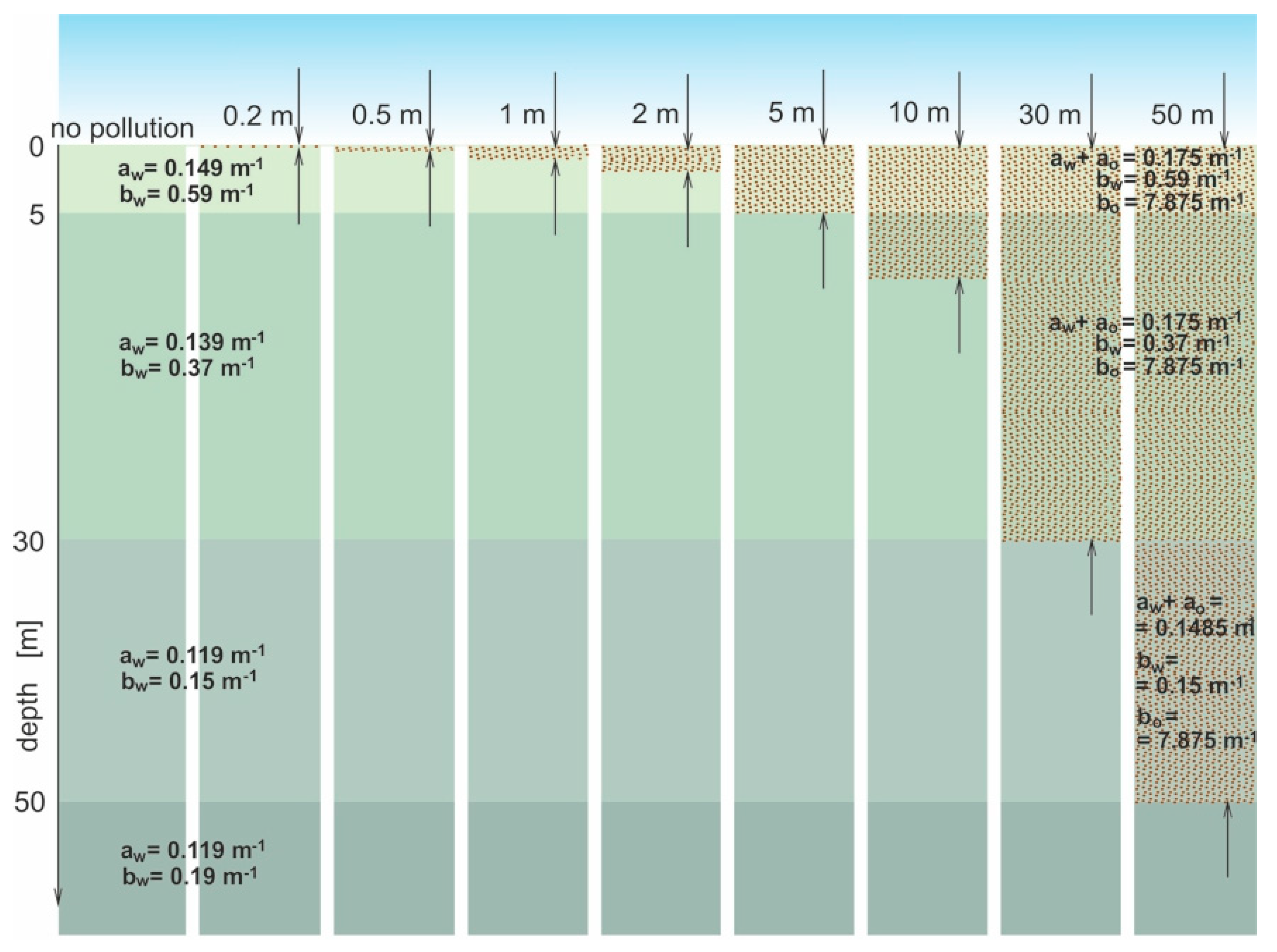
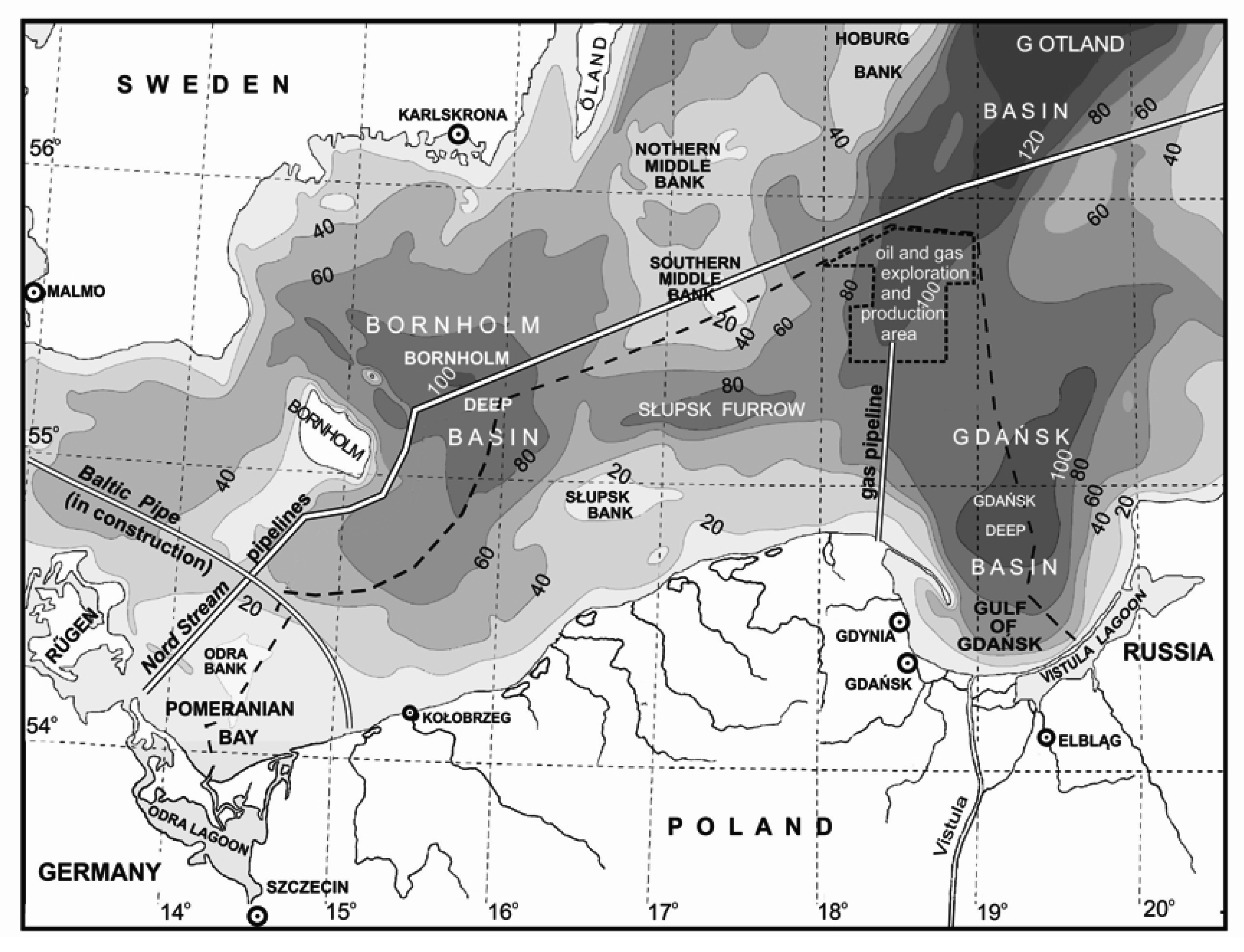

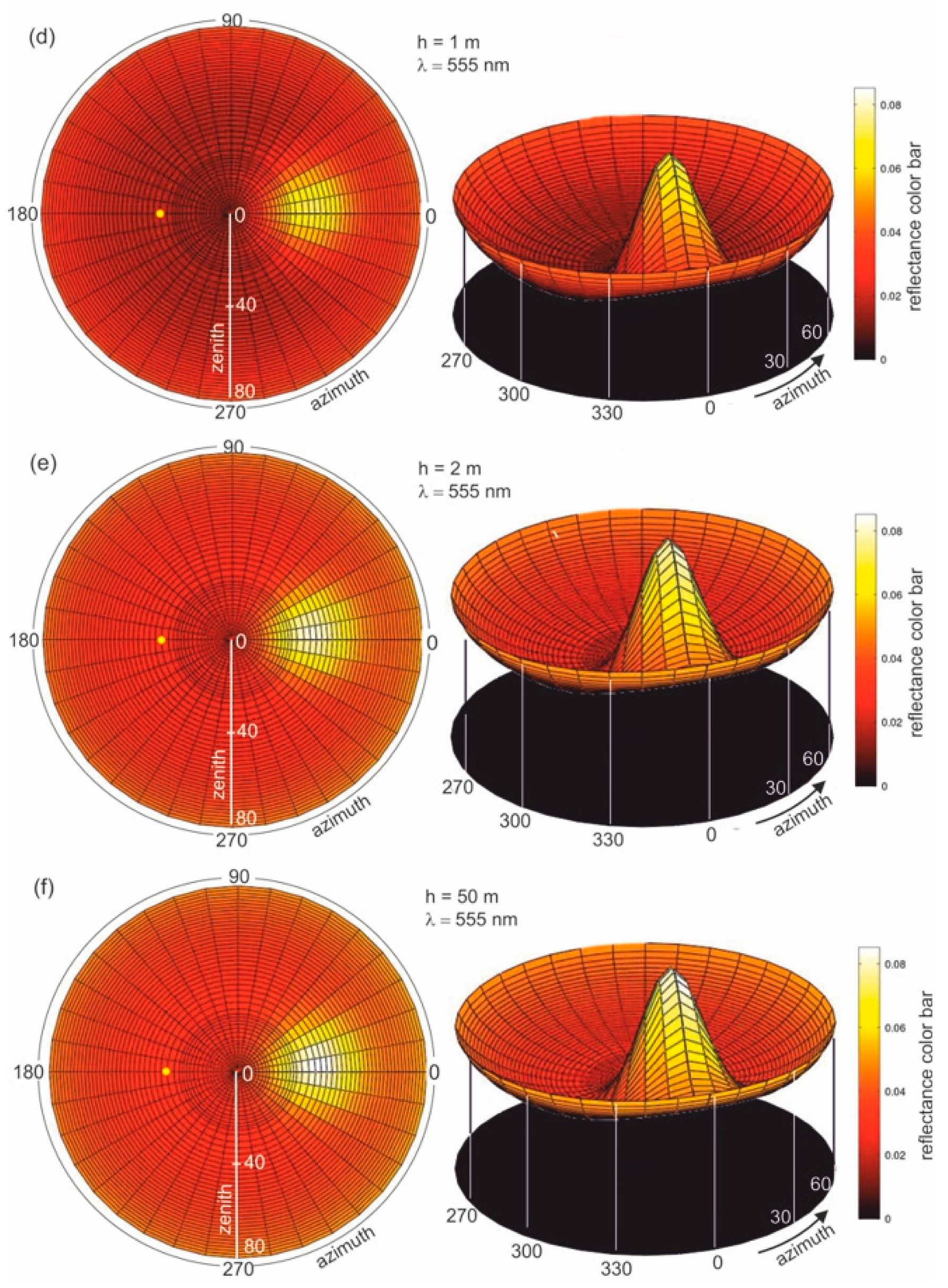
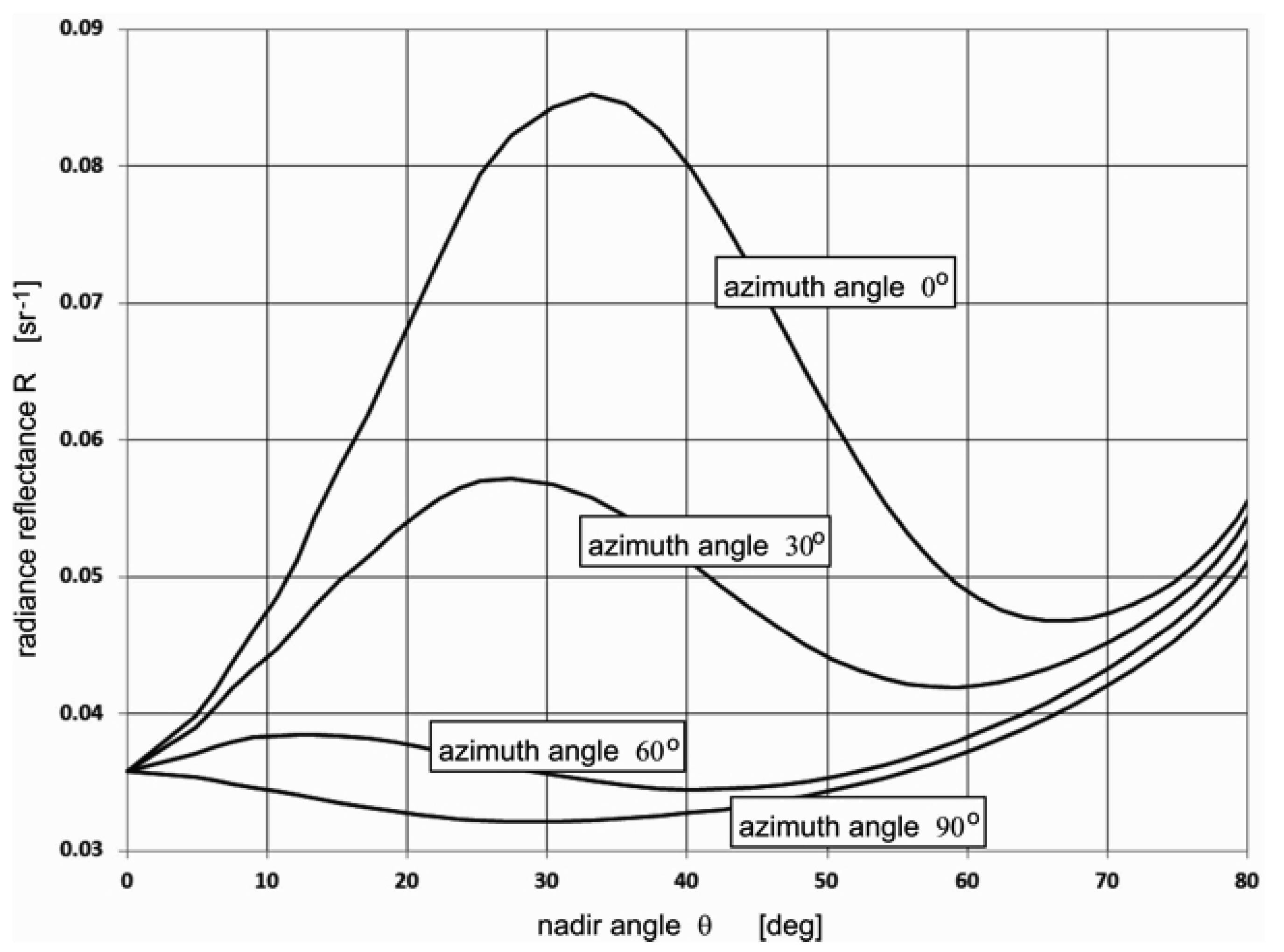
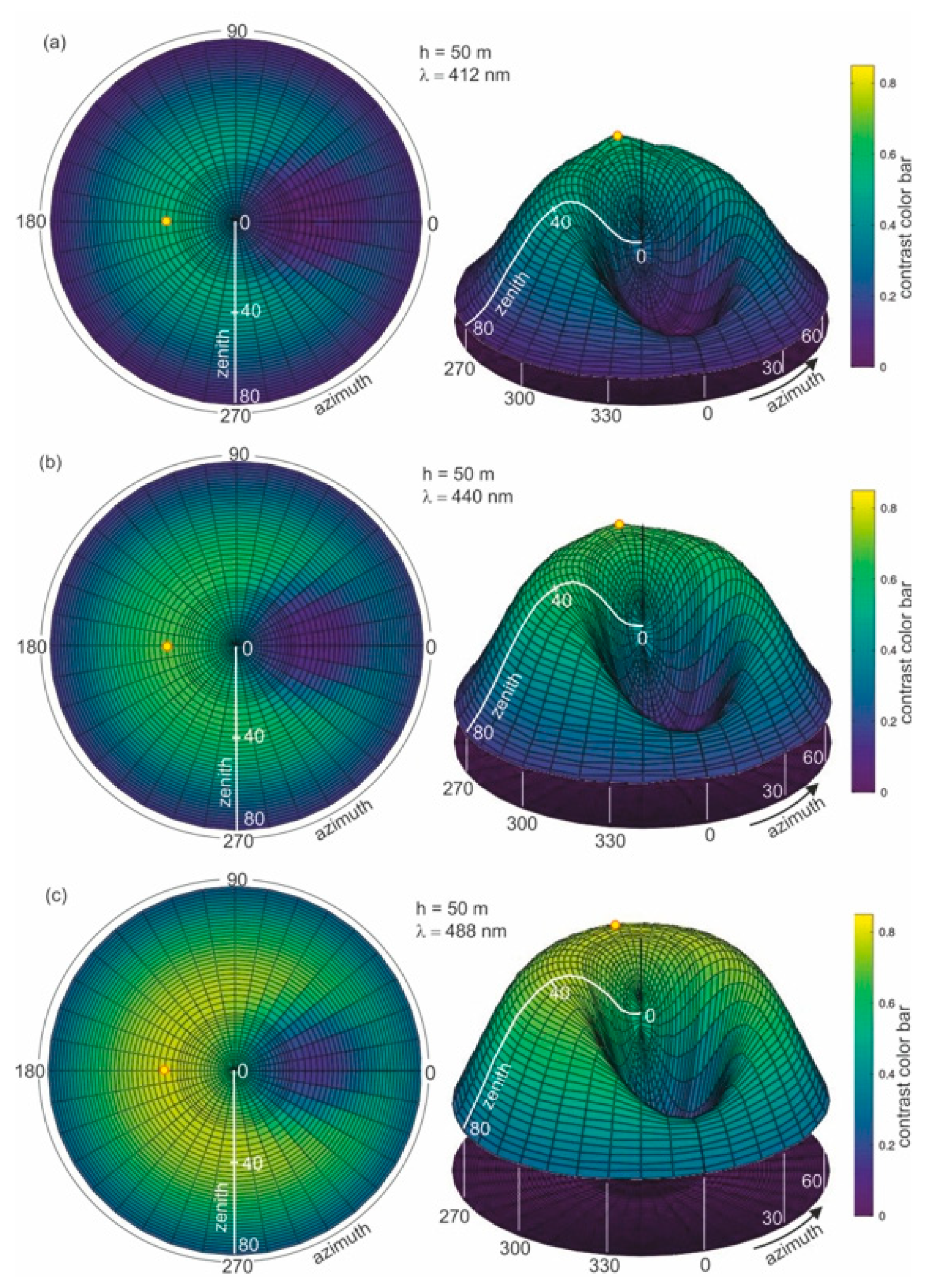
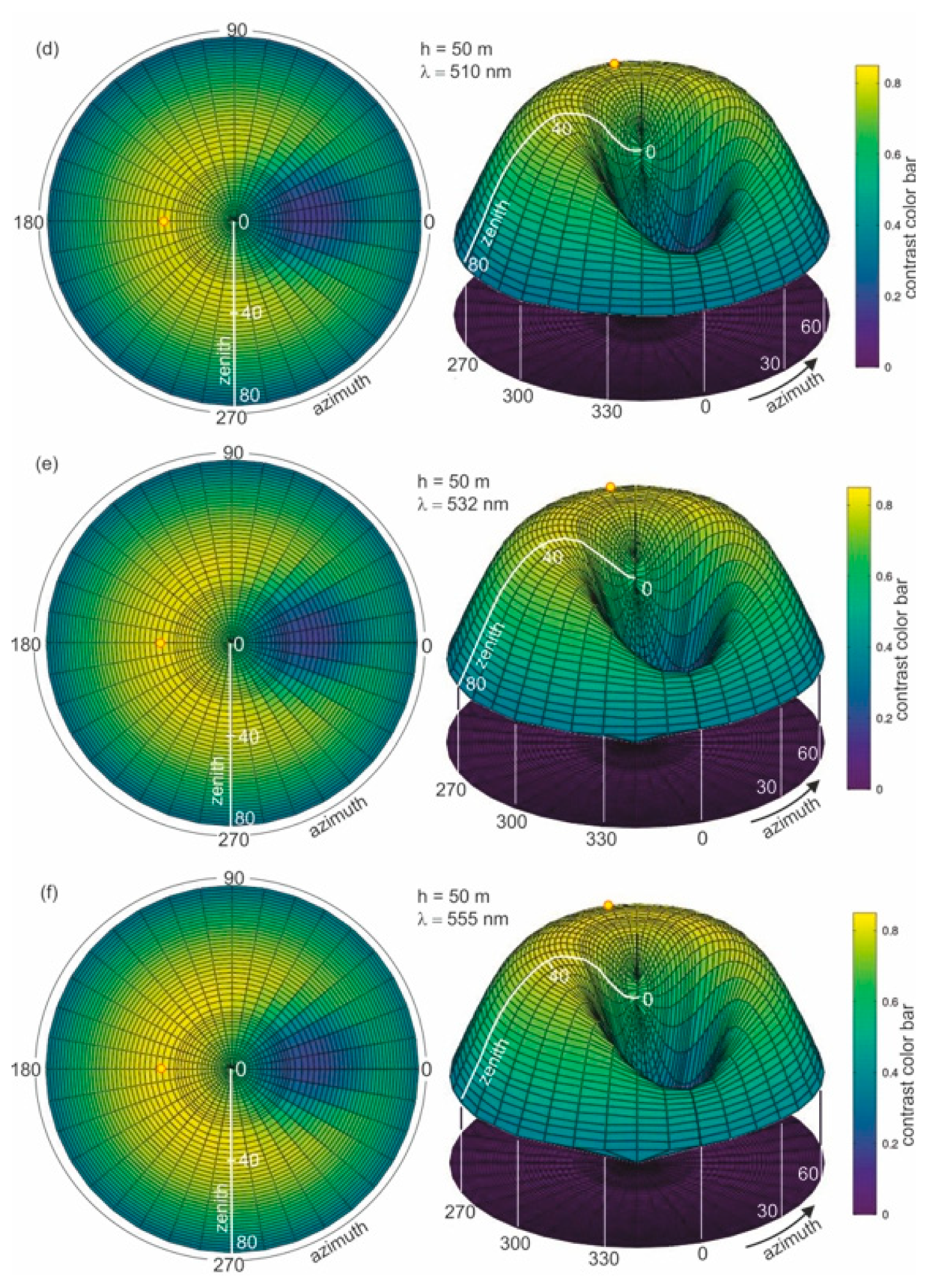

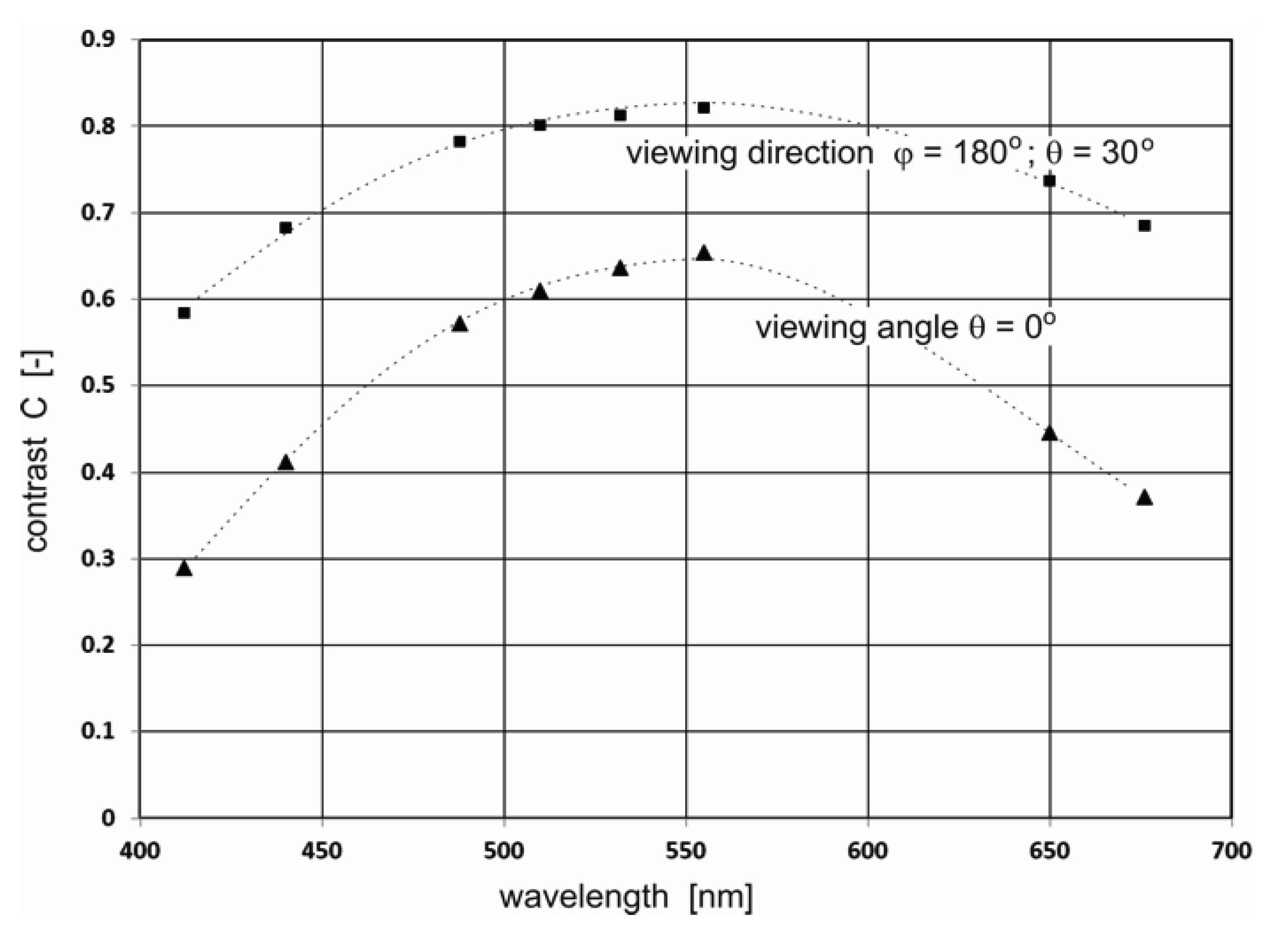
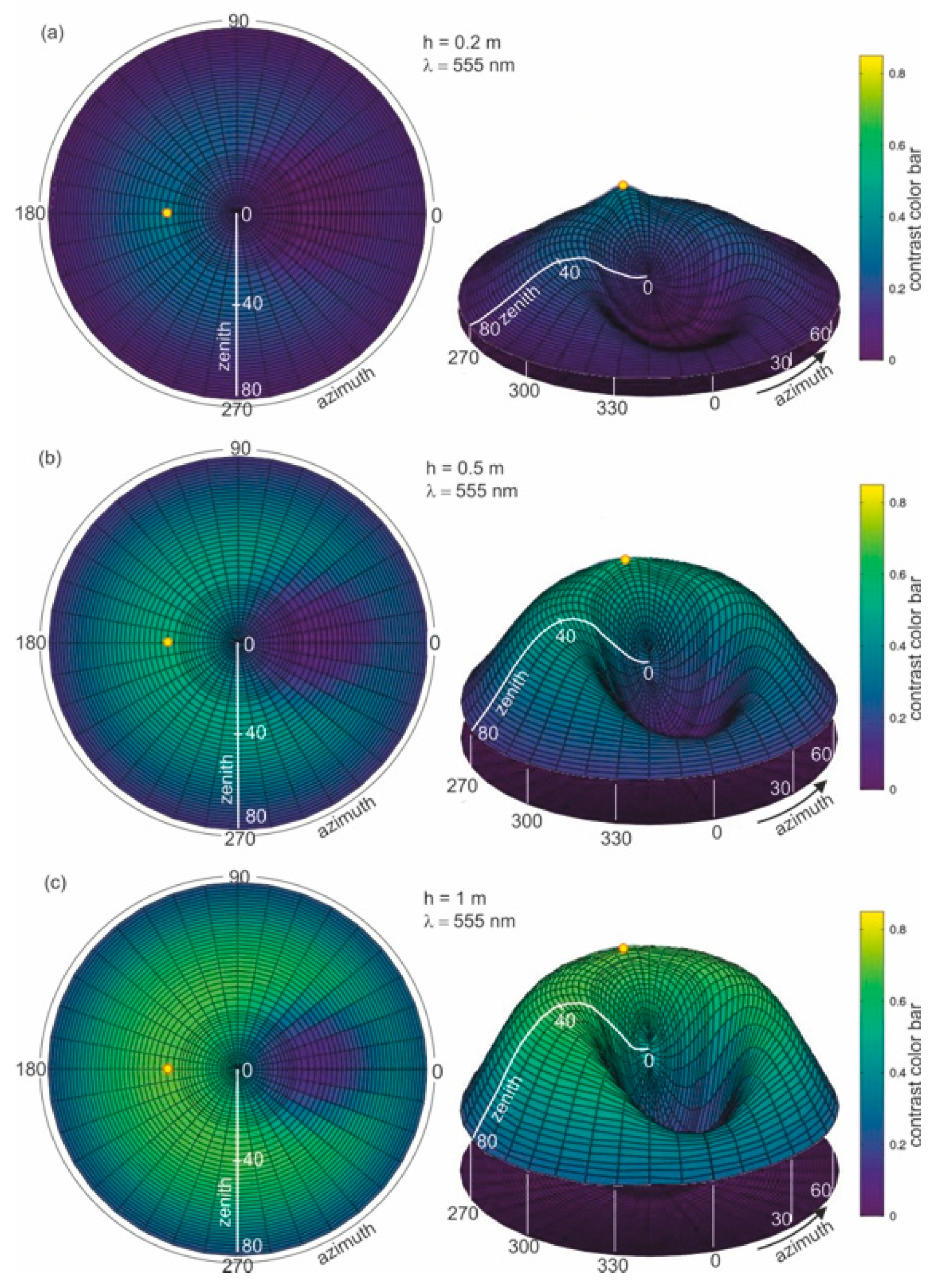
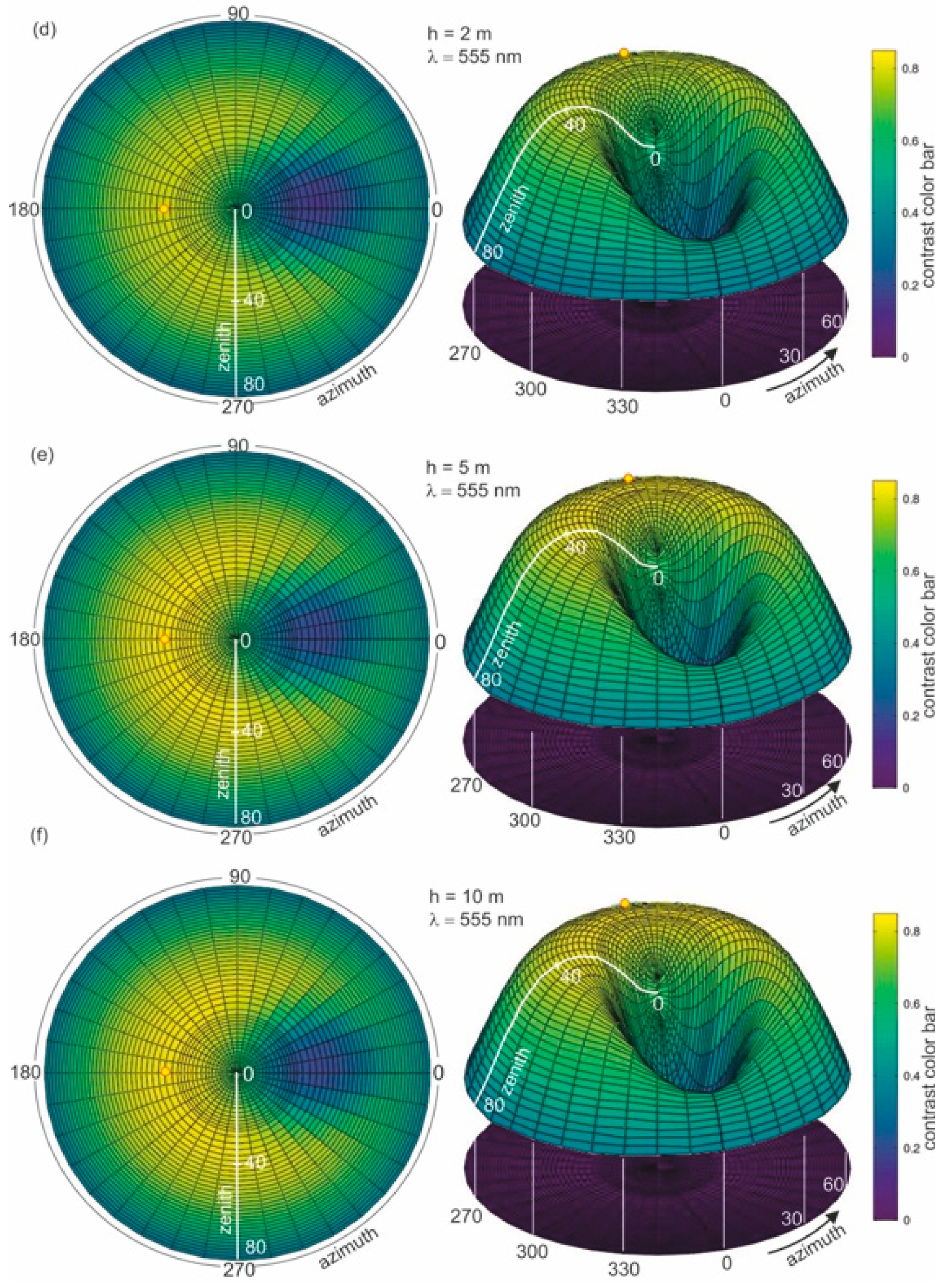

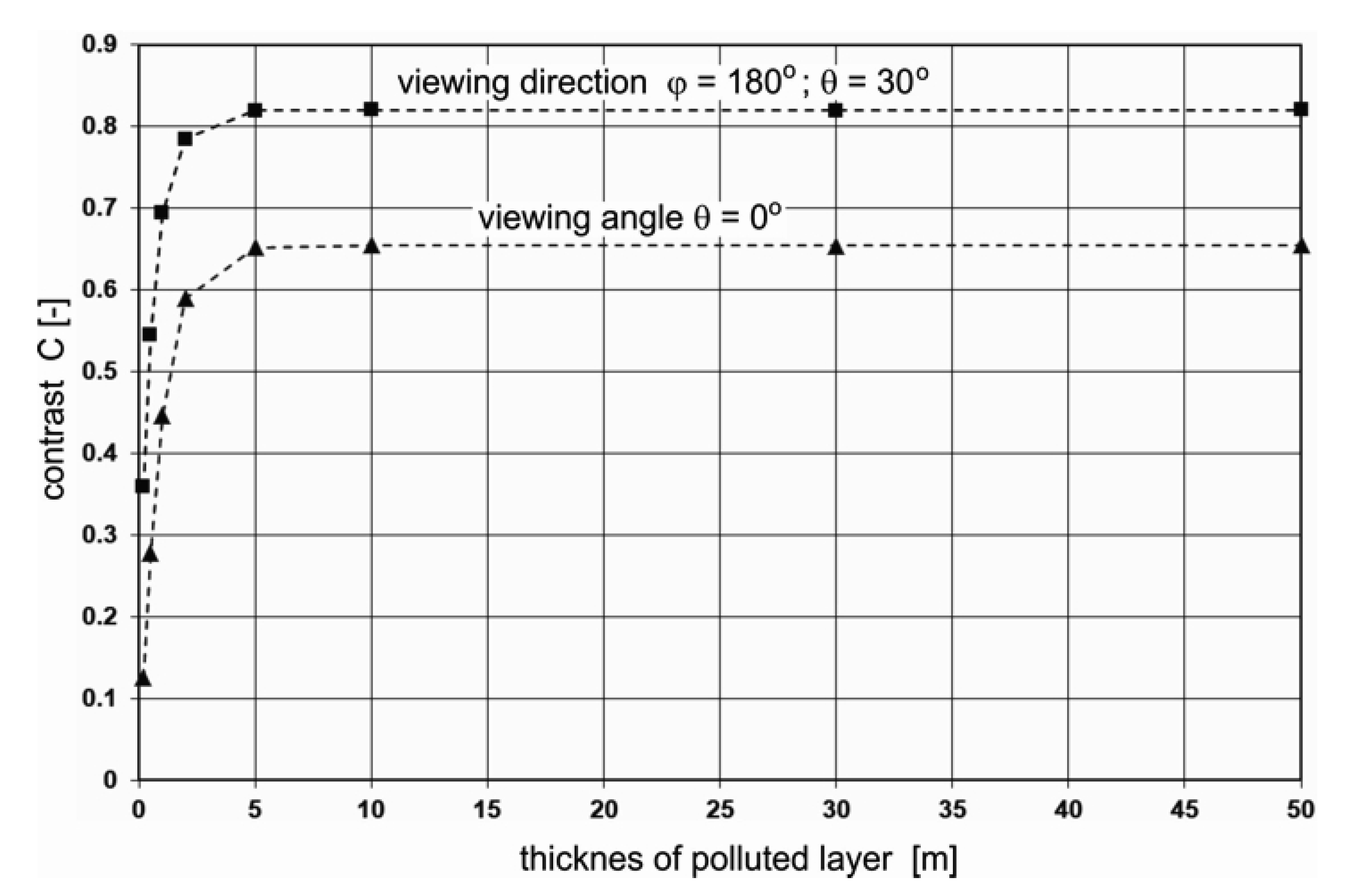
| Wavelength [nm] | Diffused Solar Irradiance Fraction | Direct Solar Irradiance Fraction |
|---|---|---|
| 412 | 0.353 | 0.647 |
| 440 | 0.338 | 0.662 |
| 488 | 0.318 | 0.682 |
| 510 | 0.312 | 0.688 |
| 532 | 0.306 | 0.694 |
| 555 | 0.301 | 0.699 |
| 650 | 0.288 | 0.712 |
| 676 | 0.286 | 0.714 |
| λ [nm] | Absorption Coefficient [m−1] | |||
|---|---|---|---|---|
| Depth < 5 m | 5–30 m | 30–50 m | Depth > 50 m | |
| 412 | 0.596 | 0.536 | 0.476 | 0.486 |
| 440 | 0.398 | 0.348 | 0.298 | 0.298 |
| 488 | 0.218 | 0.178 | 0.148 | 0.158 |
| 510 | 0.188 | 0.158 | 0.138 | 0.138 |
| 532 | 0.163 | 0.143 | 0.123 | 0.123 |
| 555 | 0.149 | 0.139 | 0.119 | 0.119 |
| 650 | 0.391 | 0.381 | 0.371 | 0.371 |
| 676 | 0.517 | 0.497 | 0.467 | 0.467 |
| λ [nm] | Scattering Coefficient [m−1] | |||
|---|---|---|---|---|
| Depth < 5 m | 5–30 m | 30–50 m | Depth > 50 m | |
| 412 | 0.63 | 0.39 | 0.14 | 0.20 |
| 440 | 0.60 | 0.37 | 0.13 | 0.18 |
| 488 | 0.60 | 0.37 | 0.14 | 0.18 |
| 510 | 0.60 | 0.37 | 0.14 | 0.18 |
| 532 | 0.60 | 0.37 | 0.14 | 0.18 |
| 555 | 0.59 | 0.37 | 0.15 | 0.19 |
| 650 | 0.54 | 0.34 | 0.14 | 0.17 |
| 676 | 0.51 | 0.32 | 0.14 | 0.18 |
| λ [nm] | Absorption Coefficient [m−1] |
|---|---|
| 412 | 0.299 |
| 440 | 0.114 |
| 488 | 0.052 |
| 510 | 0.042 |
| 532 | 0.029 |
| 555 | 0.029 |
| 650 | 0.0125 |
| 676 | 0.0087 |
| λ [nm] | Scattering Coefficient [m−1] |
|---|---|
| 412 | 7.81 |
| 440 | 7.97 |
| 488 | 7.98 |
| 510 | 7.95 |
| 532 | 7.91 |
| 555 | 7.87 |
| 650 | 7.60 |
| 676 | 7.48 |
Publisher’s Note: MDPI stays neutral with regard to jurisdictional claims in published maps and institutional affiliations. |
© 2021 by the authors. Licensee MDPI, Basel, Switzerland. This article is an open access article distributed under the terms and conditions of the Creative Commons Attribution (CC BY) license (https://creativecommons.org/licenses/by/4.0/).
Share and Cite
Baszanowska, E.; Otremba, Z.; Piskozub, J. Modelling the Visibility of Baltic-Type Crude Oil Emulsion Dispersed in the Southern Baltic Sea. Remote Sens. 2021, 13, 1917. https://doi.org/10.3390/rs13101917
Baszanowska E, Otremba Z, Piskozub J. Modelling the Visibility of Baltic-Type Crude Oil Emulsion Dispersed in the Southern Baltic Sea. Remote Sensing. 2021; 13(10):1917. https://doi.org/10.3390/rs13101917
Chicago/Turabian StyleBaszanowska, Emilia, Zbigniew Otremba, and Jacek Piskozub. 2021. "Modelling the Visibility of Baltic-Type Crude Oil Emulsion Dispersed in the Southern Baltic Sea" Remote Sensing 13, no. 10: 1917. https://doi.org/10.3390/rs13101917
APA StyleBaszanowska, E., Otremba, Z., & Piskozub, J. (2021). Modelling the Visibility of Baltic-Type Crude Oil Emulsion Dispersed in the Southern Baltic Sea. Remote Sensing, 13(10), 1917. https://doi.org/10.3390/rs13101917






